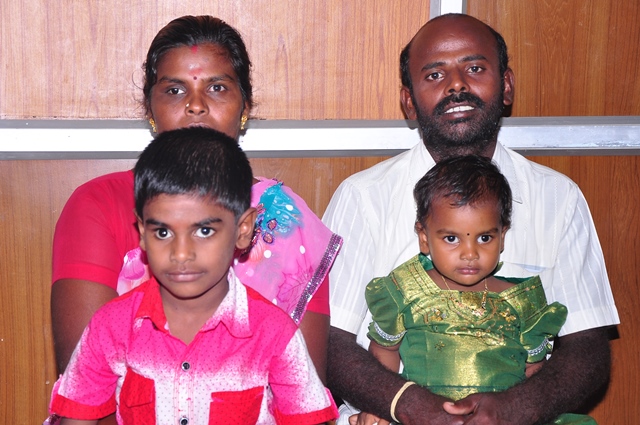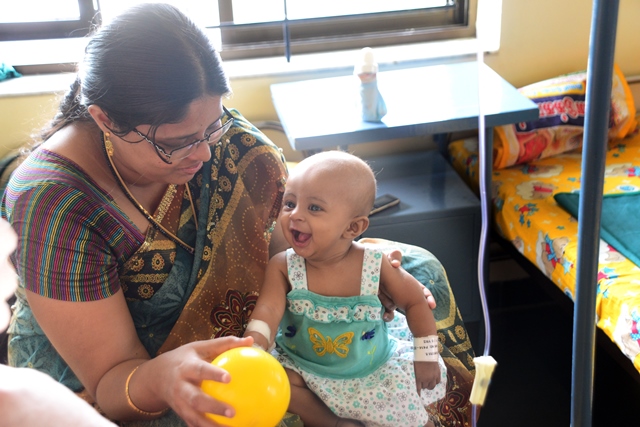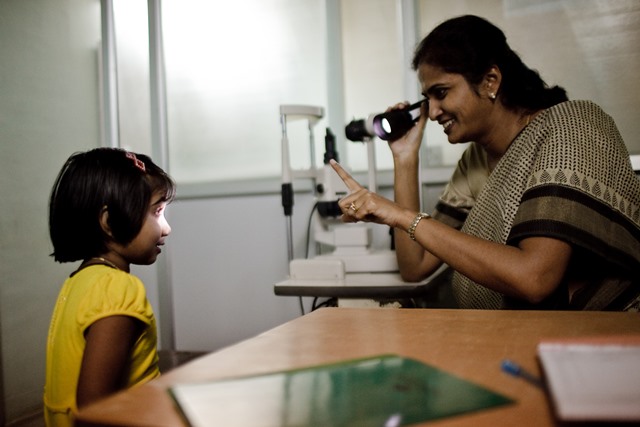Rithika Sri is a beautiful, sweet-natured child. She loves to run after her big brother, Diwakar. She first came to Aravind’s Orbit Clinic when she was 12 days old for an eye check-up. Her parents had been told to have her checked regularly, because her brother had retinoblastoma – eye cancer — three years earlier. One of his eyes was removed. Rithika’s mother had also had retinoblastoma when she was a child, and has an artificial eye. Rithika was lucky, and Aravind doctors were able to save her vision, thanks to early diagnosis. Today, Rithika and Diwakar are both healthy and cancer-free.
Kaviarasu was two years old when his parents brought him to Aravind with a swollen, reddish eye. He was diagnosed with retinoblastoma — a full course of treatment costs $1000 for surgery, chemotherapy, radiation, blood replacement, custom-made prostheses, and continuing counseling and support – well beyond the means of most Indian families. Kaviarasu’s parents are field workers and make about 65 cents a day.
Each week, the doctors and nurses at Aravind Eye Hospital in India see children like Rithikasri and Kaviarasu. Their stories don’t always have such happy endings.


What is retinoblastoma?
Retinoblastoma is a fast-spreading, often fatal, eye cancer that strikes children five years and under. Often unless diagnosed and treated in the early stages, the tumour could lead to loss of vision or death.
If a threat of the tumour spreading, the treatment involves the surgical removal of the eye – and even the surrounding structures – and as follow-up measures, chemotherapy and radiation, wherever necessary.
In cases, where the patient’s eye has to be removed as a life-saving measure, the next challenge is social in nature, as the treatment would leave the child with an empty eye socket. And so it falls upon eye care providers to rehabilitate the child by doing a prosthesis, which is an artificial eye, which would fit in the eye socket.
Most of the children who receive comprehensive treatment, in the forms of surgical intervention and social rehabilitation, do very well with the ocular prosthesis and are able to lead near-normal lives.
The miracle at Aravind
Aravind Eye Hospital has been treating children with retinoblastoma and people of all age groups with other forms of malignancy since 2007. To date, the Orbit, Oculoplasty, Ocular Oncology & Ocular Prosthetics Department in the hospital has treated and rehabilitated more than 1,000 children with retinoblastoma. To its credit, the Department has managed to treat and give useful vision to children even with advanced cases of retinoblastoma.
That said, given the gravity of the situation and the nagging concern that several could be losing their vision, generally owing to lack of early detection and treatment, the Department has been spearheading pioneering research to identify how patients could be brought in for treatment at an early stage. The Department has been probing deep into the field of genetic testing, using a technology, called Next Generation Sequencing, to test for the retinoblastoma gene to detect retinoblastoma in children. It is looking to extensively offer genetic testing for patients in a community and also for their siblings and their parents, so as to predict the sequence of events and prevent future generations from contracting the dreaded disease.


Ring of Hope
In the particular instance of retinoblastoma, in India and in the developing world, 90% of children with the disease die, because more often than not, diagnosis and treatment come too late to them. Dr. Usha Kim, head of Aravind’s Orbit and Oncology Department at Aravind Eye Hospital-Madurai, founded the Ring of Hope program to provide free treatment for children with retinoblastoma. The funding initiative is to help enable Aravind to persuade the underprivileged to get their eyes treated for retinoblastoma and for other types of cancer. It not only provides free surgical intervention but also rehabilitation in the form of giving them a prosthetic eye. Equally, in the case of retinoblastoma, as a preventive measure, the fund involves facilitating the genetic testing of potential patients with a view to early intervention and saving vision, saving lives.
Genetic testing costs about USD 200, an amount far beyond the means of many families, where the adults put together typically earn USD 2 a day. Likewise, surgical intervention and attendant procedures, like chemotherapy and radiation, and further, a prosthetic eye, come at a cost that is beyond many. Under the circumstances, the fund is a source of financial and social refuge. It so far has provided for the free treatment and rehabilitation of over a 1,000 children.
Here’s how you can help… Join the Ring of Hope family of donors
Make a contribution to the Ring of Hope fund, which will help save a child’s vision, a child’s life.
The contribution goes towards…
- Providing free surgical intervention
- Free post-operative care, including chemotherapy or radiation, or both, if necessary
- Free prosthetic eye for social rehabilitation
- Providing free genetic testing, including Next Generation Sequencing
$50 restores a child’s confidence and self-esteem with a prosthetic eye for a patient whose diseased eye has been removed.
$100 covers one chemotherapy treatment cycle for a patient operated on for eye cancer. Usually 5-6 cycles of chemotherapy are required.
$1000 pays for a full course of treatment, including surgery, radiation, and chemotherapy. It also covers travel costs for families who must make repeat visits to the hospital for on-going treatment.
To know more about Aravind Ring of Hope Project, please contact info@aravindeyefoundation.org